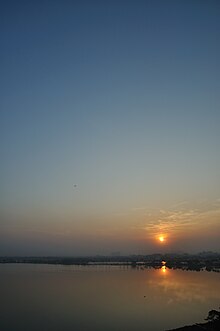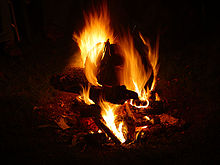Lohdi (Gurmukhi: ਲੋਹੜੀ, Devanagari: लोहड़ी, Shahmukhi: لوہڑی) is a popular South Asian festival, celebrated by people from the Punjab region of South Asia.It is also celebrated by Jammu Division of Jammu and Kashmir, Harayana and Himachal Pradesh The origins of Lohri are many and link the festival to Punjab region. Many people believe the festival commemorates the passing of the winter solstice. The belief is that Lohri represents the longest night before winter solstice as Lohri was originally celebrated on the night before winter solstice followed by the shortest day of the year which is observed on Maghi. About sixteen centuries ago, these festivals were actually observed at the point of winter solstice.
Lohri and winter solstice
Origins
There are many origins of Lohri: all forming part of folklore. However, the main theme of Lohri is the belief that Lohri is the cultural celebration of the winter solstice. According to folk lore, in ancient times Lohri was celebrated on the eve of winter solstice day. It is for this reason that people believe day light is meant to increase from the day after Lohri when the sun starts its northward journey. Accordingly, the day after Lohri is celebrated as Maghi Sangrand from when the days are meant to start getting longer. People believe nights gradually shorten "by the grain of one sesame seed" once the winter solstice passes.
However, instead of celebrating Lohri on the eve of when winter solstice actually occurs, Punjabis celebrate it on the last day of the month during which winter solstice takes place. This is due to linking Lohri to the Bikrami calendar and the twinning of the festival with Makar Sankranti which is celebrated in the Punjab region as MaghiSangrand. Therefore, Lohri commemorates the passing of the winter solstice.
Scientifically, the shortest day of the year is around 21–22 December with the longest night preceding it on the day before, after which the days begin to get longer. Accordingly, winter solstice begins on 21 December or 22 December and Lohri ought to be celebrated on the longest night before winter solstice day followed by Maghi (Makar) Sangrand on winter solstice which marks the point when daylight will increase.
Bonfire
A key feature of Lohri is the bonfire. Lighting of the fire has been common in winter solstice festivals throughout time and the world: it signifies the return of longer days. The bonfire is an ancient tradition, forming a key part of Lohri traditions. The bonfire also represents the new life of the sun which begins to reinvigorate itself on winter solstice day.
Seasonal festival
Punjabis continue to practice their Punjabi folk religion. Respect to the seasons and the natural elements of fire, wind, water and the earth is very important. In the Punjab region, the year is divided into six seasons. The Punjabi months of Maghar and Poh represent the "hemant" season when Winter is at its height. Lohri is celebrated on the last day of Poh and therefore, is a festival dedicated to the end of the Winter season, whereas Teej (known as Teeyan in Punjabi) is dedicated to the rain/Monsoon season and Basant Festival is dedicated to the Spring season. Lohri is a Punjabi festival celebrated by all faiths of the Punjab region.
Lohri and harvest festival
Lohri is traditionally associated with the harvest of the rabi crops. The traditional time to harvest sugarcane crops is January and therefore, Lohri is seen by some to be a harvest festival. The general time to sow sugarcane is January to March and the harvesting period is between December to March with a 12 to 18-month cycle. Sugarcane products such as gurh and gachak are central to Lohri celebrations, as are nuts which are harvested in January The other important food item of Lohri is radish which can be harvested between October and January. Eating mustard and spinach (sarson da saag) on Lohri is an ancient tradition. Mustard greens are cultivated mainly in the winter months because the crop is suitable to the agro-climatic conditions. Accordingly, mustard greens are also a winter produce.
Lohri and the financial new year
Punjabi farmers regard Lohri as the financial new year. New agricultural tenancies commence on Lohri[11] and rents are collected on this day. Punjabis regard the day of winter solstice as the solstice new year which is celebrated on Maghi the next day. Historically, during the 19th century, revenue for winter crops was collected either on Lohri or Maghi.







No comments:
Post a Comment